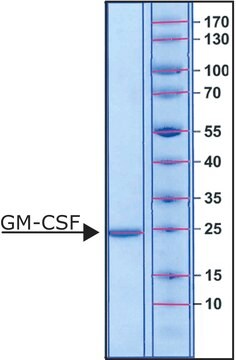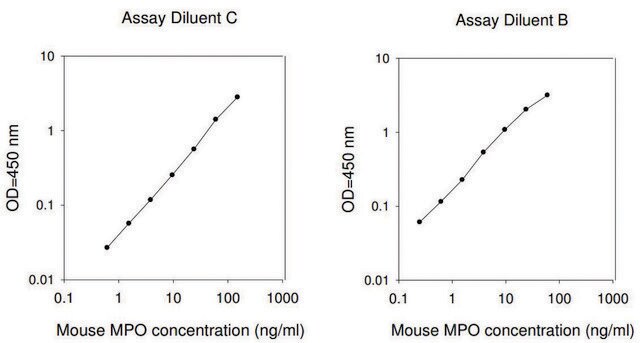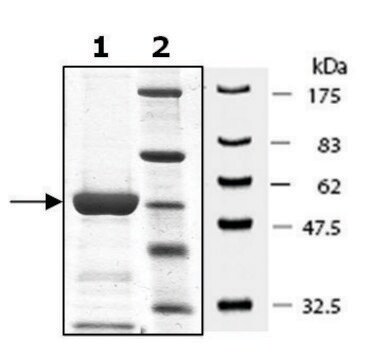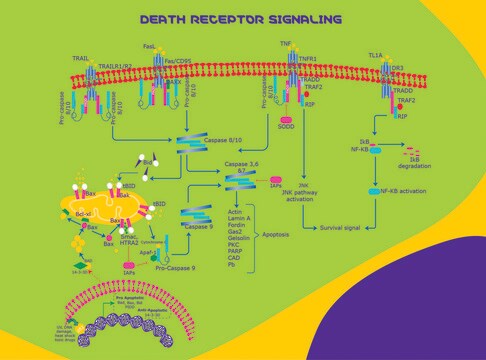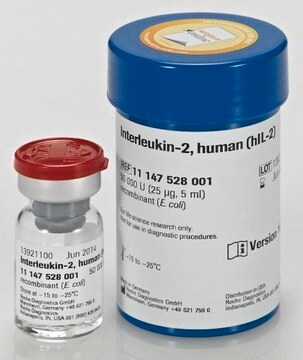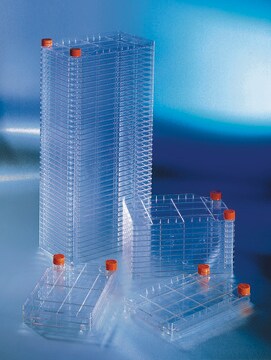추천 제품
생물학적 소스
mouse
재조합
expressed in E. coli
분석
≥98% (HPLC)
≥98% (SDS-PAGE)
형태
lyophilized
효능
10-100 ng/mL
분자량
~7.8 kDa
포장
pkg of 20 μg
불순물
endotoxin, tested
NCBI 수납 번호
UniProt 수납 번호
배송 상태
wet ice
저장 온도
−20°C
유전자 정보
mouse ... Cxcl1(14825)
일반 설명
Growth-regulated oncogenes (GRO)/keratinocyte chemoattractant (KC) belongs to the growing inflammatory protein superfamily. KC is characterized with four conserved cysteine residues with a CXC motif.
Mouse KC (also known as mouse GRO-α) belongs to the C-X-C family of chemokines. Mouse KC is a 7.8 kDa protein containing 72 amino acid residues.
생화학적/생리학적 작용
Growth-regulated oncogenes (GRO)/keratinocyte chemoattractant (KC) plays a vital role in wound healing and inflammation. In rat, serum levels of GRO/KC can be used as a predictive biomarker for inhibitory effect of chemopreventive agents on esophageal carcinogenesis.
물리적 형태
Sterile filtered and then lyophilized without any additives.
재구성
Centrifuge the vial prior to opening. Avoid freeze-thaw cycles.
Reconstitute in water to a concentration of 0.1-1 mg/mL. This solution can be diluted into other aqueous buffers.
시험 성적서(COA)
제품의 로트/배치 번호를 입력하여 시험 성적서(COA)을 검색하십시오. 로트 및 배치 번호는 제품 라벨에 있는 ‘로트’ 또는 ‘배치’라는 용어 뒤에서 찾을 수 있습니다.
Multiple berry types prevent N-nitrosomethylbenzylamine-induced esophageal cancer in rats
Stoner GD, et al.
Pharmaceutical Research, 27(6), 1138-1145 (2010)
Cloning and sequencing of a new gro transcript from activated human monocytes: expression in leukocytes and wound tissue
Iida NAOKO and Grotendorst GR
Molecular Cell Biology, 10(10), 5596-5599 (1990)
Cloning and sequencing of a new gro transcript from activated human monocytes: expression in leukocytes and wound tissue.
Iida N A O K O, et al.
Molecular and Cellular Biochemistry, 10(10), 5596-5599 (1990)
Aimalie L Hardaway et al.
Clinical & experimental metastasis, 32(4), 353-368 (2015-03-25)
Increased bone marrow adiposity is a common feature of advanced age, obesity and associated metabolic pathologies. Augmented numbers of marrow adipocytes positively correlate with dysregulated bone remodeling, also a well-established complication of metastatic disease. We have shown previously that marrow
Yuan Sun et al.
The journal of pain : official journal of the American Pain Society, 15(8), 856-866 (2014-06-03)
Chronic opioid consumption increases postoperative pain. Epigenetic changes related to chronic opioid use and surgical incision may be partially responsible for this enhancement. The CXCL1/CXCR2 signaling pathway, implicated in several pain models, is known to be epigenetically regulated via histone
자사의 과학자팀은 생명 과학, 재료 과학, 화학 합성, 크로마토그래피, 분석 및 기타 많은 영역을 포함한 모든 과학 분야에 경험이 있습니다..
고객지원팀으로 연락바랍니다.

